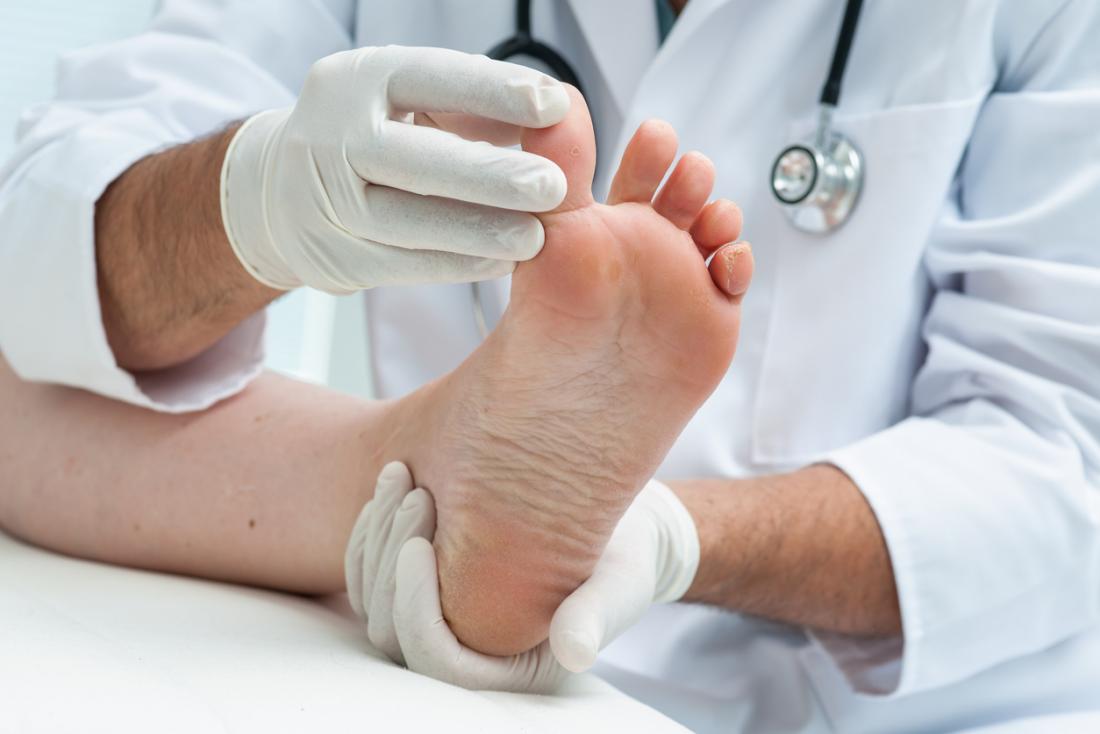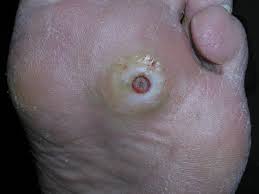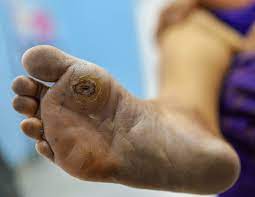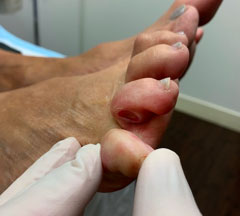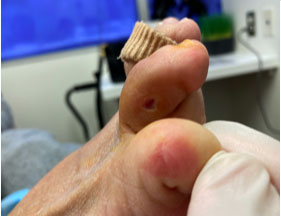Diabetes is a disease that causes faulty or insufficient insulin production or low sensitivity to insulin. Insulin is an essential hormone that is responsible for helping cells absorb sugar from the blood to use for energy. When this process does not work correctly, sugar remains circulating in the blood, causing health problems.
Prolonged periods of high sugar levels in the blood can damage many areas of the body, including the feet. Diabetes is responsible for over 50 percent of all foot amputations in the United States.
What Are the Symptoms and Signs of Diabetic Foot Problems?
- Persistent pain can be a symptom of sprain, strain, bruise, overuse, improperly fitting shoes, or underlying infection.
- Redness can be a sign of infection, especially when surrounding a wound, or of abnormal rubbing of shoes or socks.
- Swelling of the feet or legs can be a sign of underlying inflammation or infection, improperly fitting shoes, or poor venous circulation. Other signs of poor circulation include the following:
o Pain in the legs or buttocks that increases with walking but improves with rest (claudication)
o Hair no longer growing on the lower legs and feet
o Hard shiny skin on the legs
- Localized warmth can be a sign of infection or inflammation, perhaps from wounds that won’t heal or that heal slowly.
- Any break in the skin is serious and can result from abnormal wear and tear, injury, or infection. Calluses and corns may be a sign of chronic trauma to the foot. Toenail fungus, athlete’s foot, and ingrown toenails may lead to more serious bacterial infections.
- Drainage of pus from a wound is usually a sign of infection. Persistent bloody drainage is also a sign of a potentially serious foot problem.
- A limp or difficulty walking can be sign of joint problems, serious infection, or improperly fitting shoes.
- Fever or chills in association with a wound on the foot can be a sign of a limb-threatening or life-threatening infection.
- Red streaking away from a wound or redness spreading out from a wound is a sign of a progressively worsening infection.
- New or lasting numbness in the feet or legs can be a sign of nerve damage from diabetes, which increases a persons risk for leg and foot problems.
How Can Diabetes Affect My Feet?
Diabetes can cause two problems that can affect your feet:
- Diabetic neuropathy. Uncontrolled diabetes can damage your nerves. If you have damaged nerves in your legs and feet, you might not feel heat, cold, or pain there. This lack of feeling is called “sensory diabetic neuropathy.” If you do not feel a cut or sore on your foot because of neuropathy, the cut could get worse and become infected. The muscles of your foot may not work properly because nerves to the muscles are damaged. This could cause your foot to not align properly and create too much pressure on one part of your foot.
- Peripheral vascular disease. Diabetes also affects the flow of blood. Without good blood flow, it takes longer for a sore or cut to heal. Poor blood flow in the arms and legs is called “peripheral vascular disease.” If you have an infection that will not heal because of poor blood flow, you are at risk for developing ulcers or gangrene (the death of tissue due to a lack of blood).
What Are Some Common Foot Problems With Diabetes?
Anyone can get the diabetic foot problems listed below. For people with diabetes, however, these common foot problems can lead to infection and serious complications, such as amputation.
- Athlete’s foot. Athlete’s foot is a fungus that causes itching, redness, and cracking. Germs can enter through the cracks in your skin and cause an infection. Medicines that kill the fungus can treat athlete’s foot. These medicines come in pills or creams.
- Fungal infection of nails. Nails that are infected with a fungus may become discolored (yellowish-brown or opaque), thick, and brittle and may separate from the rest of your nail. In some cases, your nail may crumble. The dark, moist, and warm environment of shoes can help a fungus grow. An injury to your nail can also lead to a fungal infection. Fungal nail infections are hard to treat. Medications applied to the nail are available, but they only help a small number of fungal nail problems. You may need prescription medicine that you take by mouth. Your doctor might also remove the damaged nail.
- Calluses. A callus is a buildup of hard skin, usually on the underside of the foot. Calluses are caused by an uneven distribution of weight. Calluses also can be caused by poorly fitting shoes or by a skin problem. It’s normal to have some callus on your foot, so your doctor will decide if your callus is causing problems. If you have a callus, take care of it properly. After your bath or shower, use a pumice stone to gently remove the built-up tissue. Use cushioned pads and insoles in your shoes. Medications can soften calluses. DO NOT try to cut the callus or remove it with a sharp object.
- Corns. A corn is a buildup of hard skin near a bony area of a toe or between toes. Corns may happen because of pressure from shoes that rub against your toes or cause friction between your toes. Be sure to take care of them properly. After your bath or shower, use a pumice stone to gently remove the built-up tissue. Do not use over-the-counter remedies to dissolve corns. DO NOT try to cut the corn or remove it with a sharp object.
- Blisters. Blisters can form when your shoes rub the same spot on your foot. Wearing shoes that do not fit properly or wearing shoes without socks can cause blisters, which can become infected. When treating blisters, it’s important not to “pop” them. The skin covering the blister helps protect it from infection. Use an antibacterial cream and clean, soft bandages to protect the skin and prevent infection.
- Bunions. A bunion forms when your big toe bends toward your second toe. Often, the spot where your big toe joins your foot becomes red and callused. This area also may stick out and become hard. Bunions can form on one or both feet. They may run in the family, but most often they’re caused by wearing high-heeled shoes with narrow toes. These shoes put pressure on your big toe, pushing it toward your second toe. Felt or foam padding may help protect the bunion from irritation. Your doctor can also use a device to separate the big and second toes. If the bunion causes severe pain or deformity, you might need surgery to realign your toes.
- Dry skin. Dry skin can crack, which can allow germs to enter. Use moisturizing soaps and lotions to keep your skin moist and soft. Ask your doctor which ones to use.
- Diabetic ulcers. A foot ulcer is a break in the skin or a deep sore. They can become infected. Foot ulcers can happen from minor scrapes, cuts that heal slowly, or from the rubbing of shoes that do not fit well. It’s important to treat them as soon as you notice them. Ask your doctor for advice on how to best care for your ulcer. Up to 10% of people with diabetes will get foot ulcers.
- Hammertoes. A hammertoe is a toe that is bent because of a weakened muscle. The weakened muscle makes the tendons in your toe shorter, causing your toe to curl under your foot. Hammertoes can run in families. They can also be caused by shoes that are too short. Hammertoes can cause problems with walking and can lead to blisters, calluses, and sores. Splints and corrective shoes can treat them. In severe cases, you may need surgery to straighten your toes.
- Ingrown toenails. Ingrown toenails happen when the edges of the nail grow into your skin. They cause pressure and pain along the nail edges. The edge of the nail may cut into your skin, causing redness, swelling, pain, drainage, and infection. The most common cause of ingrown toenails is pressure from shoes. Other causes include improperly trimmed nails, crowding of the toes, and repeated trauma to the feet from activities such as running, walking, or doing aerobics. Keep your toenails properly trimmed to prevent ingrown toenails. If you have a persistent problem or if you have a nail infection, you may need a doctor’s care. Surgery to remove part of the toenail and growth plate can treat severe problems from ingrown toenails.
- Plantar warts. Plantar warts look like calluses on the ball of the foot or on the heel. They may appear to have small pinholes or tiny black spots in the center. The warts are usually painful and may grow singly or in clusters. Plantar warts are caused by a virus that infects the outer layer of skin on the soles of the feet. If you are not sure if you have a plantar wart or a callus, let your doctor decide. They have several ways to remove them.

